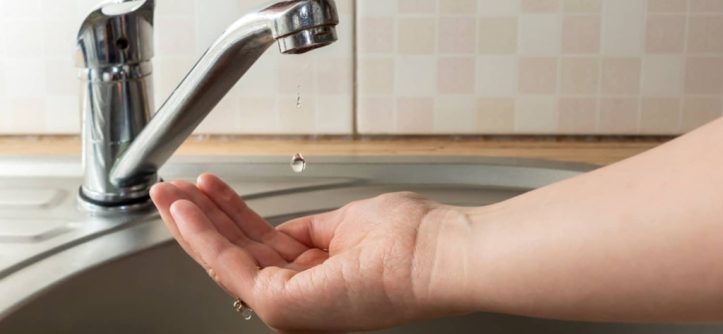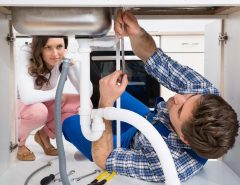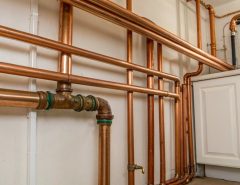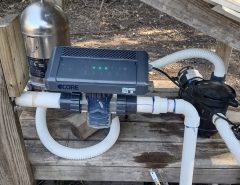Experiencing issues with your home’s water supply can be perplexing. While several factors can contribute to plumbing problems, one common culprit that often goes overlooked is air trapped within your water pipes. These air pockets, also known as airlocks, can disrupt water flow, cause strange noises, and even impact the efficiency of your appliances. Recognizing the signs early is key to a swift and effective solution.
Here are 10 common signs that indicate you might have air in your water pipes:
-
Sputtering or Spitting Faucets
This is perhaps the most tell-tale sign of air in your water lines. When you turn on a faucet, instead of a steady stream, you might experience bursts of water mixed with air, causing the faucet to “sputter” or “spit.” This happens because the trapped air is being forced out along with the water, creating an inconsistent flow.
How to Fix:
- Run the affected faucet: Often, simply running the sputtering faucet for a few minutes on both hot and cold settings can help dislodge and expel the trapped air.
- Check other faucets: If the sputtering is localized to one faucet, it might be an isolated air pocket. If multiple faucets are affected, the issue is likely systemic.
-
Gurgling or Hissing Noises from Pipes
Beyond just sputtering, you might hear distinct gurgling or hissing sounds coming from your pipes, especially when water is running. This noise is the sound of water trying to push past air bubbles, creating turbulence within the pipes. It can be particularly noticeable when flushing toilets or turning on a shower.
How to Fix:
- Listen to the source: Try to pinpoint where the gurgling is loudest. This can help identify the general area of the airlock.
- Bleed the system: As detailed in the comprehensive fix section below, bleeding your entire plumbing system is often the most effective way to address widespread gurgling.
-
Intermittent Water Flow
Do you experience moments where the water flow completely stops for a second or two, only to resume again? This intermittent flow is a strong indicator of air pockets. The air creates a temporary blockage, interrupting the continuous flow of water.
How to Fix:
- Patience and repetition: For minor intermittent flow, running the affected tap for a few minutes may resolve it.
- Systemic bleeding: If the issue persists across multiple fixtures, a full system bleed is recommended.
-
Low Water Pressure (Especially After Water Shut-off)
While low water pressure can stem from various causes, a sudden drop in pressure, especially after your water supply has been temporarily shut off (for repairs, maintenance, or due to a municipal issue), often points to air trapped in the lines. When the water supply is restored, air can get pushed into the empty pipes, leading to pressure reduction.
How to Fix:
- Gradual refilling: When your water supply is restored after an outage, open faucets slowly to allow air to escape without causing large air pockets.
- Bleed the system: This will force out any remaining trapped air that’s contributing to low pressure.
-
Banging or Hammering Noises (Water Hammer)
Loud banging or hammering sounds, often referred to as “water hammer,” can be a more severe symptom of air in your pipes. This occurs when rapidly moving water suddenly stops or changes direction, and the trapped air causes a shockwave, making the pipes vibrate violently against their supports or other structures. If left unaddressed, water hammer can damage pipe joints and fittings.
How to Fix:
- Identify the source: Try to locate the area where the banging is loudest.
- Slow down valve operation: If the banging occurs when turning off a faucet quickly, try closing it more slowly.
- Install water hammer arrestors: For persistent water hammer, particularly with appliances like washing machines, installing water hammer arrestors can absorb the shock and prevent the banging.
- Address trapped air: Bleeding the system is crucial as trapped air significantly contributes to water hammer.
-
Cloudy or Milky Water That Clears from the Bottom Up
If you pour a glass of water and it appears cloudy, milky, or opaque, but then gradually clears from the bottom up, it’s almost certainly due to tiny air bubbles. This is harmless and usually occurs when water pressure changes, or when cold water (which holds more air) warms up in your pipes. The air bubbles are simply dissolving out of the water.
How to Fix:
- No immediate action required: This sign is usually harmless and resolves itself.
- Let it sit: Simply let the glass of water sit for a few minutes, and the air bubbles will dissipate.
- Run the tap: If it bothers you, running the tap for a short period can help flush out the immediate batch of aerated water.
-
No Hot Water or Limited Hot Water Flow
An airlock can sometimes specifically affect your hot water lines. If you’re getting cold water but little to no hot water, or the hot water flow is significantly weaker than the cold, an airlock in your hot water system might be the culprit. This is because hot water systems often have lower pressure compared to the cold water mains, making them more susceptible to airlocks.
How to Fix:
- Bleeding the hot water system: There are specific methods for bleeding air from your hot water heater and associated lines.
- Connecting hot and cold mixer taps: For mixer taps, connecting the hot and cold spouts with a hose and allowing cold water to push back into the hot line can sometimes dislodge an airlock.
-
Noisy Water Heater
Your water heater might also become a source of noise if there’s air trapped within its tank or the connected lines. Gurgling, bubbling, or even rumbling sounds from the water heater can indicate trapped air, often exacerbated by sediment buildup that can also contribute to these noises.
How to Fix:
- Flush the water heater: Regularly flushing your water heater helps remove sediment, which can also contribute to trapped air and noise.
- Bleed the hot water lines: As mentioned above, bleeding the hot water system can alleviate noise caused by trapped air.
-
Radiators Not Heating Evenly or at All (for Hydronic Heating Systems)
If you have a hydronic heating system (radiators), air trapped in the system can prevent hot water from circulating effectively. You might notice that some radiators are warm while others remain cold, or that only the bottom portion of a radiator heats up. Air, being lighter than water, tends to collect at the highest points of the system, creating airlocks.
How to Fix:
- Bleed radiators: Most radiators have a bleed valve (usually a small square or slotted screw on the side) that allows you to release trapped air using a radiator key.
- Bleed the boiler system: For persistent issues, bleeding the entire boiler system might be necessary.
-
Strange Smells from Drains (Indirect Sign)
While not a direct sign of air in your water supply pipes, strange smells from drains can sometimes be an indirect indicator of issues that can lead to air in your pipes, such as a clogged vent pipe. A blocked vent pipe can create a vacuum, pulling water from P-traps and allowing sewer gases (which can smell foul) to enter your home. This disruption in the plumbing system can also lead to air entering the lines.
How to Fix:
- Clear drain clogs: Address any drain clogs promptly.
- Inspect vent pipes: If smells persist, a clogged vent pipe may require professional attention. This is a related issue that can impact overall plumbing function and potentially contribute to air problems.
How Air Gets into Your Water Pipes
Understanding how air enters your plumbing system can help in preventing future occurrences. Common causes include:
- Water main shut-off: When the municipal water supply is temporarily turned off for repairs or maintenance, the pipes in your home empty. When the water is restored, air can get pushed into the empty spaces.
- Plumbing repairs or new installations: Any time your plumbing system is drained or opened for repairs, replacements, or new fixture installations, air can enter the lines.
- Low water pressure: A significant drop in water pressure can create a vacuum, allowing air to be drawn into the pipes. This can happen with issues at the municipal level or problems with your well pump.
- Faulty well pumps: If you rely on a well, a malfunctioning well pump, a leak in the suction line, or an improperly sized pump can introduce air into your system.
- Leaky pipes or connections: Even small leaks or loose connections can allow air to be sucked into the system, especially when water pressure fluctuates.
- Sediment buildup in water heater: Sediment at the bottom of a hot water tank can cause hot spots and steam, which can then introduce air/vapor into the hot water lines.
The Ultimate Fix: Bleeding Your Plumbing System
The most effective and common way to address air in your water pipes is to “bleed” your plumbing system. This process systematically flushes out the trapped air.
Before You Begin:
- Locate your main water shut-off valve: This is crucial. It’s typically found where the main water line enters your house (e.g., in the basement, utility closet, or near the water meter).
- Gather necessary tools: You might need a bucket, towels, and a helper.
Related: How to Connect PVC to Galvanized Pipe: A Step-by-Step Guide
Step-by-Step Guide to Bleeding Your Plumbing System:
-
Turn Off Your Main Water Supply Valve:
Locate the main shut-off valve for your entire home and turn it off. This stops new water from entering the system, allowing you to drain the existing water and trapped air.
-
Open All Faucets (Hot and Cold):
Go through your entire house and open every hot and cold water faucet. This includes sinks, bathtubs, showers, and even outdoor hose bibs. Start with the highest faucet in your home (e.g., an upstairs bathroom) and work your way down to the lowest (e.g., a basement utility sink or outdoor spigot). Open them fully or at least halfway to allow for maximum air escape.
-
Flush All Toilets and Run Water-Using Appliances:
Flush all toilets until they no longer refill. For appliances like washing machines and dishwashers, you can run a short rinse cycle or a drain cycle if possible. The goal is to drain as much water as possible from the system.
-
Wait for All Faucets to Run Dry:
Allow sufficient time for all the water to drain from your pipes. The time this takes will vary depending on the size of your home and plumbing system. You should hear the water flow diminish and eventually stop at all opened fixtures.
-
Turn the Main Water Supply Back On (Slowly):
Once all the water has drained, return to your main water shut-off valve and slowly turn it back on. Turning it on too quickly can introduce more air.
-
Allow Water to Run Through All Fixtures:
With the main water supply back on and all faucets still open, allow the water to run for 10-15 minutes. You should notice sputtering and gurgling as the air is expelled, eventually giving way to a steady, smooth flow of water without noise.
-
Turn Off Faucets in Reverse Order:
Once the water flow is steady and quiet at all fixtures, begin turning off the faucets. Start with the faucet farthest from the main water supply and work your way back to the closest one. This helps maintain consistent pressure as the system refills. When turning off toilets, turn off the closest faucet first, then flush the toilet.
-
Check for Residual Issues:
After turning off all faucets, listen for any lingering noises. Run each faucet individually to confirm smooth, air-free flow.
Related: How to Remove Oatey shower Drain Cover – The Easy Way
Preventing Future Air Issues
While bleeding your system is effective, taking preventative measures can minimize future occurrences:
- Slowly restore water after outages: If your water supply is interrupted, turn on your main water valve slowly when the supply is restored.
- Ensure proper plumbing installation: If you’re undertaking new plumbing work or repairs, ensure a qualified professional handles it to minimize air introduction.
- Address leaks promptly: Fix any dripping faucets or leaky pipes immediately, as they can be entry points for air.
- Regular well pump maintenance: If you have a well, ensure your well pump is properly maintained and sized for your home.
- Install air vents (for specific systems): In some complex or large plumbing systems, installing automatic air vents at high points can help release trapped air.
- Consider a whole-house water filter: This can reduce sediment buildup, which can indirectly contribute to air issues in water heaters.
When to Call a Professional
While many air-in-pipe issues can be resolved with DIY bleeding techniques, there are instances where professional help is advisable:
- Persistent issues: If you’ve followed the bleeding steps and the problem persists or returns quickly.
- Severe water hammer: If the banging is very loud, frequent, and doesn’t subside, it could indicate a more serious underlying issue that requires expert diagnosis and repair.
- Suspected pipe damage: If you suspect a burst pipe, significant leak, or other structural damage to your plumbing.
- No hot water after bleeding: If you’re still experiencing a complete lack of hot water despite attempts to bleed the system.
- Unusual odors or discolored water: While cloudy water from air is harmless, if you notice strange smells (other than slight metallic smells after bleeding) or discolored water (brown, yellow, green), it could indicate a more serious problem with your water supply or internal plumbing.
- Inability to locate or operate main shut-off: If you can’t find or safely operate your main water shut-off valve.
Related: How long you can use your hose for well
Conclusion
Air in your water pipes can be a frustrating plumbing nuisance, but it’s rarely a sign of catastrophe. By understanding the common signs and knowing how to effectively bleed your plumbing system, you can often resolve these issues yourself, restoring peace and smooth water flow to your home. However, don’t hesitate to seek professional assistance if the problem is persistent, severe, or points to a more complex underlying plumbing issue. A well-maintained and air-free plumbing system ensures efficient water delivery and a more comfortable home environment.






Leave a Reply